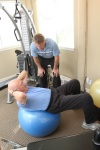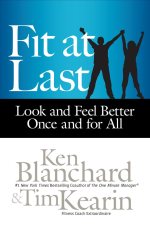 After analyzing four years of check-in data, Gold’s Gym found that February 18 is the date with the steepest drop-off in gym attendance. And it may be the day you are most likely to quit your own New Year’s resolution around fitness.
After analyzing four years of check-in data, Gold’s Gym found that February 18 is the date with the steepest drop-off in gym attendance. And it may be the day you are most likely to quit your own New Year’s resolution around fitness.
It’s a common experience, explains best-selling business author Ken Blanchard.
“Nearly all of us have made a New Year’s resolution and then not followed through. Why is it that most New Year’s resolutions don’t work? Two reasons—the first is that accomplishing the goal is tougher than we thought.”
The second reason? “We rarely get help from the people around us,” says Blanchard. “People smile and say ‘I’ll believe it when I see it,’ and then walk away to let us tackle the resolution on our own.”
If you’re already thinking of giving up on your fitness goal, Blanchard urges you to first ask for help from a coach or a friend—someone who will help you maintain your commitment to your commitment. Then apply this 3-step process to give yourself the best chance of succeeding:
Set clear goals. All good performance starts with clear goals. Blanchard recommends the SMART approach, along with a compelling reason that motivates you to achieve the goal. “I had set a goal to become fit many times,” Blanchard explains. “But this time, I found a compelling reason to get healthy: my puppy, Joy. I was just turning 70 when I got her. Knowing dogs can live 15 years or more, I decided I needed to stay healthy through my mid-80s, so not only would I be around for my family, but also for Joy. Most people worry about outliving their dog; I worried about my dog outliving me!”
Diagnose your current status. Once goals are set, the next step is to diagnose your development level on each of the tasks related to your goal. Blanchard explains that your development level is a function of competence (your skills and experience) and commitment (your motivation and confidence.)
“For example, let’s say you’re excited about learning to lift weights but don’t know anything about it. That makes you an Enthusiastic Beginner—you have no competence but high commitment. You’ll need a lot of direction. But when it comes to eating healthy, maybe you’re a Disillusioned Learner—you lack competence and you’ve also lost your commitment. You’ll need both direction and support in this area.”
 Get the help you need. The fact that you have different development levels on different tasks or goals means you need to find someone who can provide you with the directive behavior or supportive behavior you need for each task or goal.
Get the help you need. The fact that you have different development levels on different tasks or goals means you need to find someone who can provide you with the directive behavior or supportive behavior you need for each task or goal.
Drawing on his previous example, Blanchard explains, “As an Enthusiastic Beginner on weight training, you need specific direction—someone to tell you exactly how to lift weights. As a Disillusioned Learner on diet and nutrition, you need both direction and support—someone who not only will help you learn how to eat right, but also will listen to you and praise you as you change the way you eat. Enlisting a partner who will give you the proper amounts of direction and support will keep you accountable and reap great benefits. If your partner also has a goal similar to yours, that’s the perfect match—you can keep each other on track!
Don’t Go It Alone
Few people can accomplish a major life change by themselves. Ken Blanchard finally succeeded when he asked for help to achieve his fitness goals. He turned to a friend, fitness expert Tim Kearin, for direction and support.
Kearin helped Blanchard establish goals and diagnose his current state in six key areas:
- Aerobics
- Strength training
- Balance
- Flexibility
- Weight control/Nutrition
- Sleep/rest
“The only aspect of fitness where I was an expert was rest and sleep,” laughs Blanchard. “I can sleep anywhere! So that wasn’t an issue for me.”
But when it came to both strength training and balance, Kearin identified Blanchard as an Enthusiastic Beginner—excited about the idea of getting stronger, but needing a directing leadership style.
“In terms of aerobics, flexibility, and nutrition/weight control, Tim and I determined I was a Disillusioned Learner. I had started programs in these areas at various times over the previous 30 years but hadn’t kept up with them, so I was frustrated. In these areas I needed a coaching leadership style—which means I needed direction and also caring support.”
With Kearin’s help, Blanchard was able to finally make progress in all six areas. And at the conclusion of the journey they wrote a book together about the experience—Fit at Last: Look and Feel Better Once and for All.
 How about you? Struggling with fitness goals? It’s not unusual. Consider Blanchard’s approach. You don’t need a personal trainer—just someone who is willing to work with you to help you set goals, identify your development level and what kind of help you need on each goal, and then take the steps to achieve those goals.
How about you? Struggling with fitness goals? It’s not unusual. Consider Blanchard’s approach. You don’t need a personal trainer—just someone who is willing to work with you to help you set goals, identify your development level and what kind of help you need on each goal, and then take the steps to achieve those goals.
It’s all about managing your journey to health and fitness—and committing to your commitment—with a little help from your friends.
PS: You can learn more about Blanchard’s journey here: Fit At Last book page.
About the Author
More Content by David Witt
























